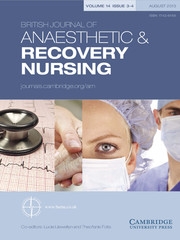No CrossRef data available.
Article contents
Going Dutch: Anaesthetising in the Netherlands and Other Issues
Published online by Cambridge University Press: 15 June 2005
Abstract
This paper discusses the role, responsibilities and practices of anaesthetic practitioners in the Netherlands in relation to their counterparts in the United Kingdom (UK), these practitioners representing an important yet overlooked section of the health care workforce. This takes place in the context of the UK National Health Service (NHS) modernisation agenda and the European Commission's (EC) aim to enhance the mobility of health care staff throughout the European Union (EU) through standardisation of variations in qualifications, skill levels, methods and working practices (Bologna, 1999; Lisbon Strategy, 2000; EHTAN, 2005).
It is clear that significant disparities remain between anaesthetic practitioners in both countries and that we need to explore ways of arriving at compatibility between the different grades. However, this does not currently appear to be happening at EU level. Despite the huge responsibilities on these practitioners, this sector of the EU health care workforce remains largely invisible and there appears to be no concerted attempt at EU level to develop appropriate competencies for them. Further research is required into this area, including: evaluative studies of policies for service redesign and new roles, professional regulation and the impact on outcomes for health service users.
- Type
- Original Article
- Information
- Copyright
- © 2005 Cambridge University Press


